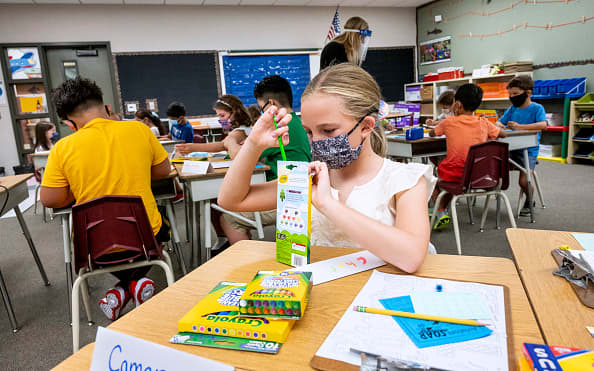
A student works on her name tag in a second and third grade combo class during the first day of school at Laguna Niguel Elementary School in Laguna Niguel, CA on Tuesday, August 17, 2021.
Paul Bersebach | MediaNews Group | Getty Images
Families with children may more relief to look forward to in the coming years, thanks to the Democrats’ $3.5 trillion budget plan.
House Democrats passed the budget resolution on Tuesday, meaning that the party can begin to write the details of the plan. They hope to pass it via reconciliation, a process that would mean they can push the budget through without any Republican votes.
The outline that lawmakers are beginning with would invest trillions of dollars to boost the social safety net for families through programs and services such as an expanded child tax credit, childcare benefits for working parents, free pre-K and more.
More from Invest In You:
How to get monthly child tax credit without a permanent address
Lack of workers hurts small business ability to keep up with demand
How this 26-year-old TikTok creator makes over $100,000 per month
Investments in working families, the elderly and the environment would total about $1.8 trillion, according to an early fact sheet about the proposal.
“I always had confidence; I never doubted that the president’s budget would prevail because of the commitment our caucus has to America’s working families,” said House Speaker Nancy Pelosi, D-Calif., in a press event Wednesday.
Here is what is expected in the plan for children and their families.
Tax breaks and more
The plan would likely continue several tax credits that benefit low- and middle-income families, and especially those with children.
It would extend the child tax credit, earned income tax credit, child and dependent care tax credit, and paid family and medical leave, according to a fact sheet outlining the budget resolution.
The American Rescue Plan in March enhanced the child tax credit, boosting the benefit to $3,000 from $2,000 for children 17 and younger and giving an additional $600 for kids under the age of 6. Half of the credit started going out to families in July as monthly payments.
This credit alone will help some 65 million children across the U.S., roughly 90% of kids in the country, according to the Center on Budget and Policy Priorities. It will also lift some 4.1 million children out of poverty, slashing the overall poverty rate by about 40%. Continuing the credit — which so far is only for the 2021 tax year — will mean these benefits continue.
Children and their families would also potentially be helped by planned investments in childcare and education baked into the proposal. Senate Democrats would like to extend universal pre-K to 3- and 4-year-old children and expand childcare benefits for working families.
The plan would also make community college tuition-free, give money to institutions serving minorities and increase the maximum Pell Grant award to help people attend and pay for higher education. Child nutrition programs would also get a boost.




